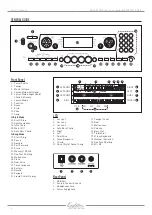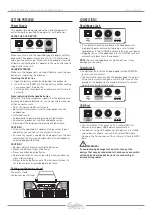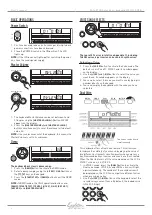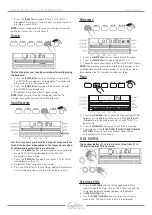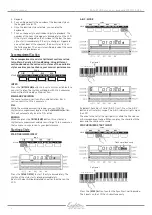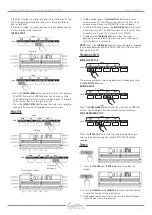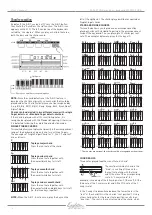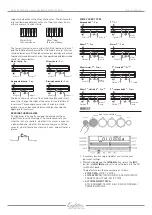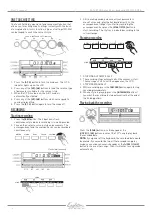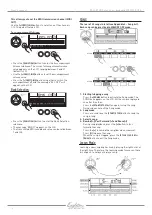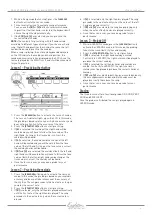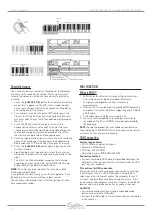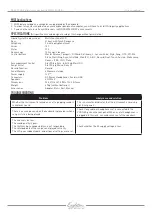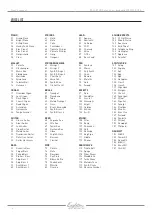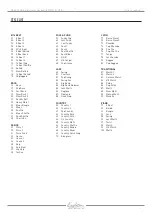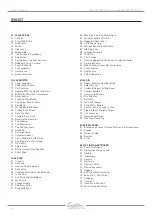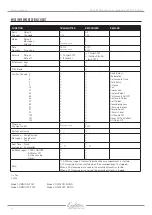
10
eagletone.com
User’s manual
EAGLETONE electronic keyboard MPW300 USB
Chord recognition
By default, the A.B.C. mode is off. Press the A.B.C. button
to activate the “Auto Bass Chord” function. The A.B.C. icon
appears on the LCD. The left-hand area of the keyboard is
called the “chord area”. When you play a chord in that area,
both the bass and the chord sound.
STYLE
SONG
A.B.C.
MAIN/FILL
INTRO/END
START/STOP
SYNC
Split point
Accompaniment range
Root notes and the corresponding keys
D
C D E F G A B C D E F
E
B
F
D
E
F
G
STYLE
NOTE: Since the chord detection of the A.B.C. feature is
based on the chord root priority, some chords that could be
played under the Chord Dictionary may not be recognized by
it, e.g. B6, B
b
6, B6(9), B
b
6(9), B aug, B
b
aug, Bm6, B
b
m6, Adim7,
B
b
dim7, Bdim.
Chords can be detected in two different ways: with «single
finger detect» or «Standard finger detect» method.
If the chord is played with all its constituting notes, it is
recognized as played with the Standard fingering. Otherwise,
it is detected following the single finger detection mode.
SINGLE FINGER CHORDS
This method allows you to play chords easily in the accompaniment
range of the keyboard using only one, two or three fingers.
The examples of Single Finger Chord for “C, Cm, C7 and Cm7”
are as follows:
C
C
m
C
7
C
m7
To play a major chord
Press the root note of the chord.
To play a minor chord
Press the root note together with
the nearest black key to its left.
To play a seventh chord
Press the root note together with
the nearest white key to its left.
To play a minor seventh chord
Press the root note together with
the nearest white and black keys to its left
(i.e. the three keys together).
NOTE: When the A.B.C. function is on, play the keys on the
left of the split point. The chords played will be recognized as
Single Finger chords.
STANDARD FINGER CHORDS
This method allows you to produce an accompaniment by
playing chords with standard fingering in the accompaniment
range of the keyboard. You can play up to 32 chords per root
note. The examples below are given for the key of C:
4
CM
(9)
5
C
m
6
C
m6
7
C
m7
8
C
m7
(b5)
9
C
m
M
7
10
C
dim
11
C
dim7
12
C
7
13
C
7sus4
14
C
7
(13)
15
C
sus4
20
C
7sus4
21
C
7
(
b
5)
22
C
7
(9)
23
C
7
(
#
11)
24
C
7
(
b
13)
25
C
7
(
b
9)
26
C
7
(13)
27
C
7
(
#
9)
28
C
M7aug
29
C
7aug
30
C
sus4
31
C
1+2+5
0
C
2
CM
7
3
C
aug
1
C
6
16
C
mM7
(9)
17
C
dim
18
C
dim7
19
C
7
These notes are optional; the chords could be recognized without them.
CHORD BASICS
Three notes played together constitute a “chord”.
root
3rd
3rd
The most basic kind of chord is the
“triad”, consisting of three notes:
the root note along with the third
and fifth notes of the corresponding
scale. A “C major triad”, for
example, is made up of the following notes: C (the root), E (the
third note of the C major scale) and G (the fifth note of the C
major scale).
In the C major triad mentioned above, the lowest note is the
“root” of the chord (this is the chord’s “root position”). Using
other chord notes for the lowest note position results in an
“inversion”. The root is the central sound of the chord, which









